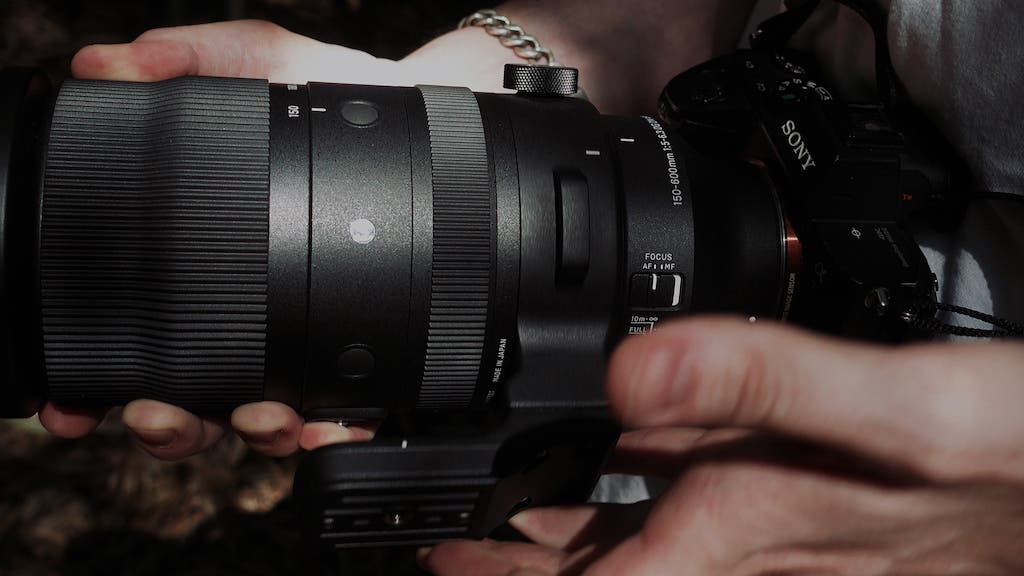Super zoom lenses have always been controversial. The conventional wisdom says that a lens that is “good” at everything is never great at anything. Historically, zooms with a large focal range have never been that sharp. their slow apertures have made them useful only in bright lighting conditions. However, Sigma has really flipped conventional wisdom on its head with their new e-mount, the Sigma 150-600 Sport Line Lens.

With such a massive focal range, I knew there was only one way for me to test this thing out— and that’s by going on safari! Unfortunately, the Serengeti is about 7,000 miles away and COVID is still very much a thing. So, I just had to settle for a little trip to the zoo.
Once you get this lens out of the case, you’ll notice you’re definitely getting a professional piece of equipment. Just like Sigma’s other high-end lenses in their Sports Line, this lens was made in Japan. You can feel the quality and care that was put into its design. Its fully metal construction adds a bit of weight but it is absolutely worth it. This is a lens you’ll be able to count on for years to come.

Optical stabilization
I figured that most reviews of this lens would be about its photo capabilities so I wanted to do something different. I’d heard the optical stabilization in this lens was greatly improved over previous models. In this test, I tried the unthinkable and shot handheld video all the way up to 600 millimeters. To say I was blown away would be an understatement. I truly couldn’t believe how good the optical stabilization is. Sure, I still got a little camera shake while zoomed all the way in to 600mm. Although, I couldn’t believe how smooth it was. It’s so smooth that you’d have zero problems shooting stills even at slower shutter speeds.

This lens has two different modes for stabilization. Mode 1 is the general mode that will be used most of the time. Mode 2 is used when tracking a subject side-to-side. This is great for auto racing and sports action. Although, since none of the animals were moving fast, I didn’t get to play with it much. If you’re shooting on a tripod or just want to turn the stabilization off completely, there is also an off position.

The lens also has a customizable switch on the bottom with two different modes. Using the Sigma USB dock and the Sigma Optimization Pro software, you can create and import your own custom OS/AF settings right to the lens.

Focusing
On the side, you’ll also find a Focus Limiter switch with three different settings. Basically, you can use this to speed up the autofocus if you know your subject will be inside or outside of ten meters. The settings are up to ten meters, ten meters to infinity, and full range. So, if you were on a real safari and you knew the animals would be farther than 33 feet away, you could set the switch to the middle setting and it would help you quickly grab focus. While the lens definitely focuses faster using these switches, I generally opted to keep it on the “full” setting because I was getting shots both close up and far away.
The last switch on the side is a standard autofocus on/off switch. This came in handy at the zoo because the lens kept focusing fences rather than the animals behind them. The manual focus ring has a great feel to it as well though, and manually focusing was a breeze.

Buttons and switches
Another thing you’ll notice about this lens is that it has three assignable buttons that can be customized. I chose to map one of them to toggle APSC mode. This meant that I could punch in on the full frame sensor even further and get a focal length equivalent to nearly 1000mm!

The last of this lens’ many switches is the zoom lock. It has three different modes. When set to S mode, the zoom ring has the least amount of friction. Although, if left to hang upside down, the entire lens will extend out. T mode makes the zoom function require a bit more effort, but it will remain in place with the lens pointed down. Finally, the lock mode does exactly what it sounds like it and locks the lens in place at any focal length.

Tripod collar
Another thing I thought was pretty cool about this lens is the tripod collar. With just a quick twist of a knob, it rotates and clicks nicely into place. It makes the transition between landscape and portrait shots fast and easy. Speaking of fast, the collar also has a built-in tripod plate right on the bottom. This means you’ll waste no time moving your tripod plate back and forth between multiple lenses.

As important as all of these features are, nothing is more important than image quality. This lens definitely doesn’t disappoint. The lens has 24 elements in 16 groups including two FLD and three SLD elements. Basically, it’s sharper than any super zoom lens I have used before. I was pleasantly surprised to find that, even wide open at 600mm, I was able to get super sharp images with no visible vignetting.
At the end of the day, the Sigma 150-600 Sport Line Lens is truly the most capable super zoom I have ever used. It is absolutely worth considering for anyone from sports shooters to birding enthusiasts.
The Sigma 150-600 Sport Line Lens well be available for Sony e-mounts and l-mounts at Adorama for $1,499 in late August.






